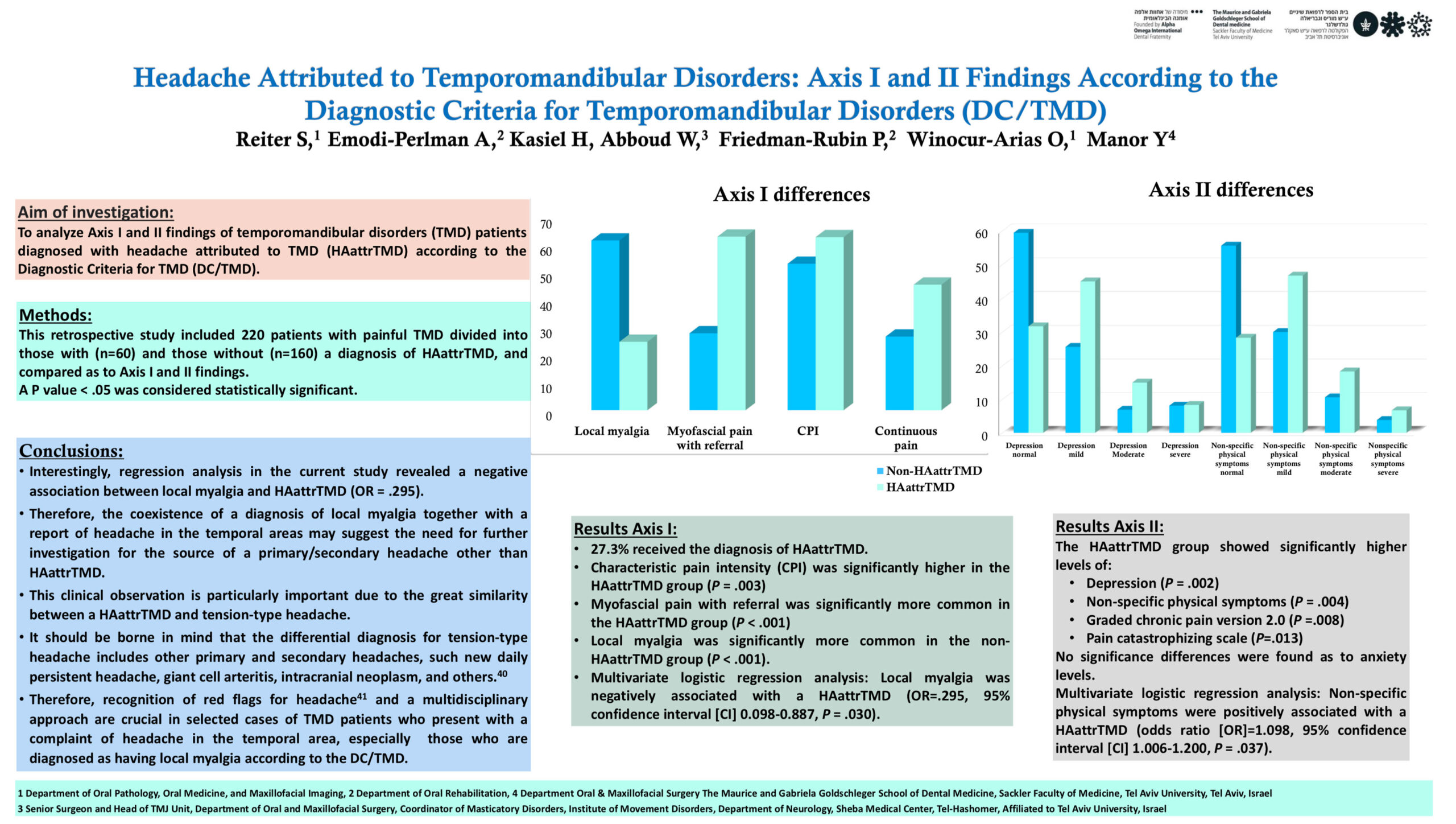This POSTER has VIDEO and IMAGE elements. Hover over the image above and use the ![]() arrows to navigate
arrows to navigate
Headache Attributed to Temporomandibular Disorders: Axis I and II Findings According to the Diagnostic Criteria for Temporomandibular Disorders (DC/TMD)
Reiter, S1*, Emodi-Perlman A2*, Kasiel H**, Abboud W3, Friedman-Rubin P2, Winocur O1, Manor Y4.
*Contributed equally to this article
**This study was undertaken in partial fulfillment of an DMD thesis at the Maurice and Gabriela Goldschleger School of Dental Medicine, Tel Aviv University, Tel Aviv, Israel
1 Department of Oral Pathology, Oral Medicine, and Maxillofacial Imaging, The Maurice and Gabriela Goldschleger School of Dental Medicine, Sackler Faculty of Medicine, Tel Aviv University, Tel Aviv, Israel
2 Department of Oral Rehabilitation, The Maurice and Gabriela Goldschleger School of Dental Medicine, Sackler Faculty of Medicine, Tel Aviv University, Tel Aviv, Israel
3 Senior Surgeon and Head of TMJ Unit, Department of Oral and Maxillofacial Surgery, Coordinator of Masticatory Disorders, Institute of Movement Disorders, Department of Neurology, Sheba Medical Center, Tel-Hashomer, Affiliated to Tel- Aviv University, Israel
4 Department Oral & Maxillofacial Surgery, The Maurice and Gabriela Goldschleger School of Dental Medicine, Sackler Faculty of Medicine, Tel Aviv University, Tel Aviv, Israel
Abstract
Aim of investigation:
To analyze Axis I and II findings of temporomandibular disorders (TMD) patients diagnosed with headache attributed to TMD (HAattrTMD) according to the Diagnostic Criteria for TMD (DC/TMD).
Methods:
This retrospective study included 220 patients with painful TMD divided into those with (n=60) and those without (n=160) a HAattrTMD and compared as to Axis I and II results. A P value < .05 was considered statistically significant.
Results:
27.3% received the diagnosis of HAattrTMD. Myofascial pain with referral was significantly more common in the HAattrTMD group (P < .001), while local myalgia was significantly more common in the non-HAattrTMD group (P < .001). Characteristic pain intensity (CPI) was significantly higher in the HAattrTMD group (P = .003), which also showed significantly higher levels of depression (P = .002), non- specific physical symptoms (P = .004), graded chronic pain (P =.008) and pain catastrophizing scale (P =.013). Non-specific physical symptoms were positively associated with a HAattrTMD (odds ratio [OR]=1.098, 95% confidence interval [CI] 1.006-1.200, P = .037). Local myalgia was negatively associated with a HAattrTMD (OR=.295, 95%CI 0.098-0.887, P = .030).
Conclusions:
Myofascial pain with referral was significantly more common in the HAattrTMD group than local myalgia. Painful TMD patients who report temporal headache and are diagnosed as having local myalgia rather than myofascial pain with referral probably do not have a HAattrTMD. Therefore, searching of red flags for headache and a multidisciplinary approach are crucial in these selected cases of TMD patients.
Acknowledgements and/or Funding Source: None




Leave A Comment